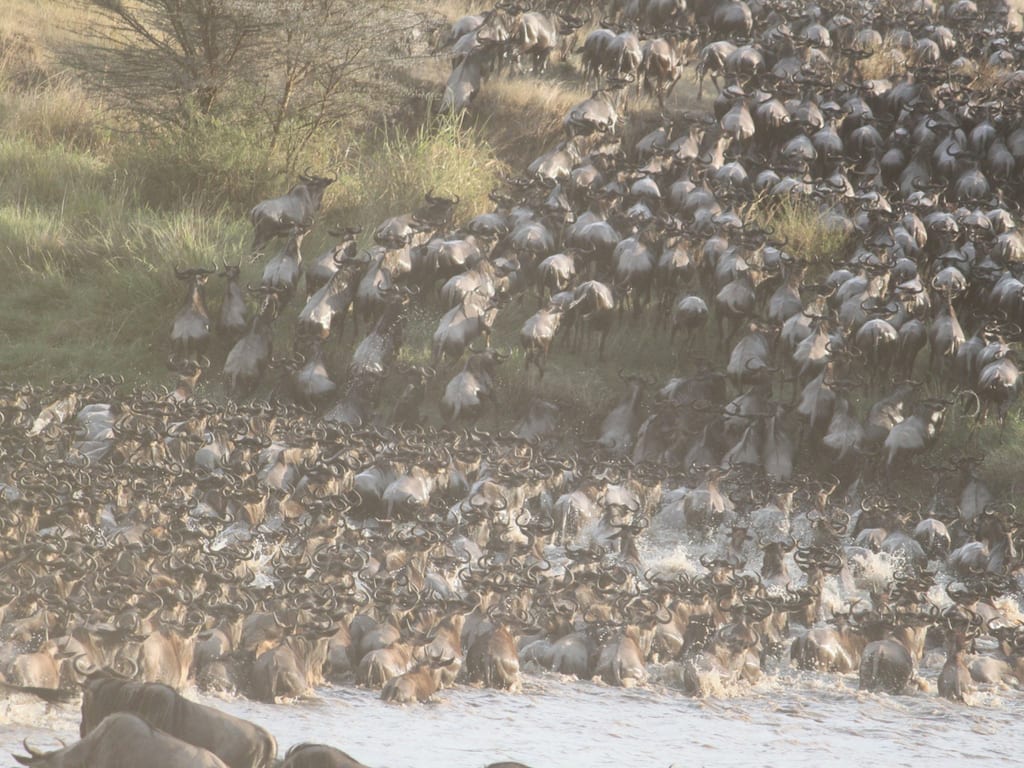The annual wildebeest migration from the Serengeti in Tanzania to the Masai Mara is one of the greatest natural spectacles on earth.
So magnificent in fact, that an extra wonder of the world was specifically created to honor the Great Migration of Africa.
As with many mythical beasts, the eighth wonder of the world is not always entirely understood. Here are some facts about the Great Wildebeest Migration that might surprise you and will definitely give you good general knowledge.
1. The migration in the Masai Mara and the Serengeti is an event that is neverending.
No-one is actually migrating! The herds simply follow the food around in a big lap of the Serengeti National Park, briefly popping over the border into Kenya on their tour. When people speak of the Great Migration they often only refer to the outward leg of the journey. The time following the calving season (while the Migration is in Tanzania) and until the wildlife reaches Kenya, is the section of the migration that most people refer to when they speak of the Great Migration.
2. Around 3 million animals take part in the great migration
There are around 1.7 million wildebeest and hundreds of thousands of zebra (because wildebeest and zebras eat different parts of the grass these two species do not mind traveling together). Also, almost half a million gazelle take this road trip across 200,000 square miles of woodland, hills, open plains and through rivers together. 4,500 tonnes of grass is consumed every day during the great migration. The migration also hosts around 3,000 lions.
3. The great migration from Tanzania changes every month and every year
The only determinant of the schedule is the arrival of rain, which governs the availability of food in its turn. When rains end around May or June the animals start struggling for grazing land and so they start moving north towards the River Talek and their dry season habitat in the Mara.
4. Along the route, there are many very treacherous gauntlets for the herds to move through.
Crocodile infested rivers, feline predators who feast at will and other carnivores who are keen to take advantage of the general chaos. Two hundred and fifty thousand wildebeest and thirty thousand zebras will never return to the starting point as they become food or perish from thirst or exhaustion during the migration.
Start planning your luxury safari to Tanzania today
5. The vast areas that the herds travel through have remained almost unchanged for a million years.
It has also been the ancestral home of the Maasai for centuries and humans and wildlife continue to live side by side.
6. There are no night drives or walks allowed in the National Parks of the great migration.
You can only enjoy night drives and bush walks in private concessions along the path of the migration.
7. A wildebeest is also known as a gnu.
A wildebeest calf can run within two minutes of being born.
8. Between January and March, around half a million calves are born in the Southern Serengeti before the wildebeest migration to the Masai Mara. This is one of the best times to go to the Serengeti.
Get your Fast Great Migration Guide by Month
10. From July to October, the trek moves from the west to the east of the river and water crossings happen daily at different points.
A herd of wildebeest possesses what is known as ‘swarm intelligence’, where the wildebeest systematically explore and overcome an obstacle as one. The entire phenomenon is leaderless.
11. Without the migration, there is no Serengeti.
The migration is vital to the ecology and sustains the 3000 lions and countless other predators who live along the way. The migration is part of the reason a luxury safari in the Serengeti is always an excellent plan for nature lovers.
Did you know: It is never too early to book your Great Migration safari? All the best camps in the Serengeti and the Masai Mara fill up quickly so give one of our specialist Travel Designers a call today and start planning your safari to Tanzania and Kenya immediately.







